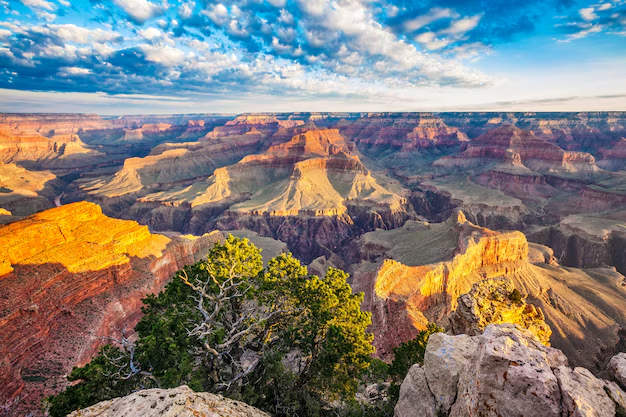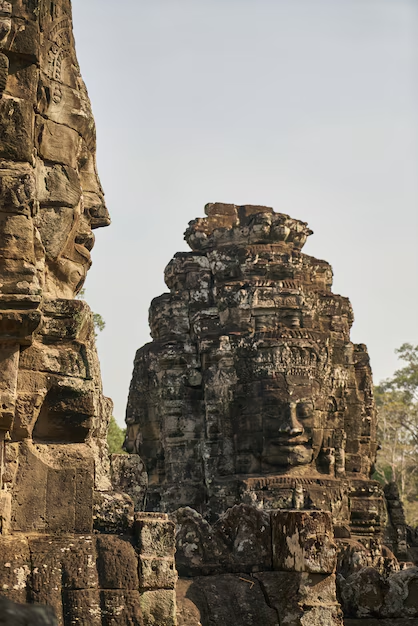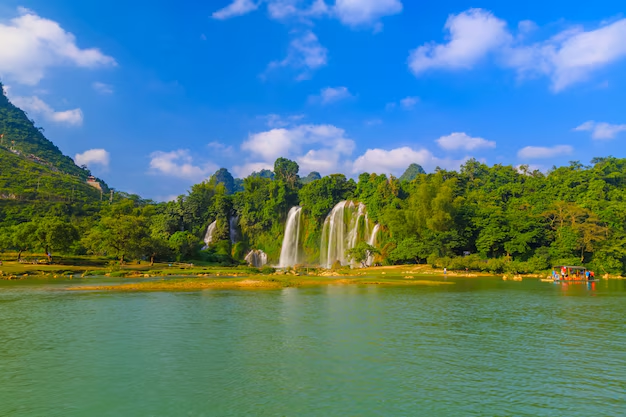Introduction
Idaho is well-known for its potatoes, but it also has some of the country’s most breathtakingly beautiful natural settings. Idaho, tucked away in the Pacific Northwest, is home to a staggering variety of best national parks, monuments, and preserves renowned for their breathtaking mountains, distinctive volcanic formations, pure rivers, and abundant wildlife. Idaho’s national parks, with their untamed peaks of the Sawtooth Mountains and their breathtaking depths of Hells Canyon, are ideal for nature lovers, adventurers, and history buffs alike. In this blog, we will examine the top ten best national parks in Idaho, emphasizing their main draws and advising on how to get the most out of your trip.

1. Yellowstone National Park

Although Yellowstone National Park is mainly in Wyoming, sizable portions are in Montana and Idaho. With its abundance of riches, it is likely to please outdoor enthusiasts and nature lovers. It is home to rough landscapes, scenery, and nature.
1872, Yellowstone was the world’s first national park, safeguarding an astounding variety of breathtaking natural vistas. This region is highly volcanic, home to an astonishing 50% of the planet’s geysers and an abundance of bubbling mud pots and hot springs. Grand Prismatic Spring and Old Faithful are the most well-liked among them because of their grandeur, magnitude, and majesty.
Although many tourists are drawn to the stunning geothermal sites, the area’s lush forests, sheer canyon walls, and towering mountains are alluring. Many tourists go animal watching, with hiking and camping being popular activities. The area is home to several moose, grizzly bears, and wolves. One of the most breathtaking locations to travel in the United States is Yellowstone National Park, which boasts abundant pristine and unspoiled natural beauty.
2. Craters of the Moon National Monument & Preserve

Craters of the Moon National Monument was created in 1924 and safeguarded several lava-scarred, surreal-looking landscapes. It is located in Central Idaho, not far from Twin Falls, and was formed thousands of years ago during a major volcanic eruption. Despite its desolate and dreary surroundings, the area is breathtaking.
Enchanting cinder cones and craters rise from the untamed landscape, while lava flows and tube caverns can be spotted sometimes. A portion of the Great Rift volcanic zone has cracks and vents and a few resilient plants and animals that survive in its barren and damaged regions.
3. City of Rocks National Reserve

The magnificent City of Rocks National Reserve is located in the state’s south-central region, close to the borders with Nevada and Utah. It has enormous boulders, unique formations, breathtaking views, and landscapes everywhere you turn, making it a trendy destination for hikers and rock climbers.
With its uneven rocks, sharp peaks, and spindly spires, this once-significant signpost for traders and travelers on the California Trail is now breathtaking. It has been protected as a park since 1957 and got its name from a fantastic circle of interlocking gray granite rocks.
Its rocky boundaries are home to lovely hiking trails and excellent rock climbing among its massive, 100-meter-tall boulders. In addition, camping is a cozy option in City of the Rocks, and hunting and horseback riding are well-liked activities.
4. Hagerman Fossil Beds National Monument

Just northwest of Twin Falls, close to the little town of the same name, is Hagerman Fossil Beds National Monument, one of the most remarkable fossil sites in the United States. In addition to having a large collection of Hagerman horse fossils, the monument features many educational and engaging exhibits about the area’s history and well-known discoveries.
The remarkable variety of fossils found at the Hagerman Horse Quarry makes it one of the most significant paleontological sites in the nation. These creatures, which date back to the late Pliocene Epoch, range from fish and frogs to ground sloths, mastodons, and saber-toothed cats.
Look at thousands of years-old fossils of plants and animals while browsing the vast collection in the visitor center. But without question, the Hagerman horses are the highlights, as they have contributed much to our understanding of the development of horses.
5. Nez Perce National Historical Park

This unique National Historical Park honors the Nez Perce people’s history, culture, and legends and is near the Washington border in northwest Idaho. Among its expansive valleys, flower-filled meadows, and majestic mountains, there are 38 significant sites to visit— 26 of which are located in the Idaho portion of the park.
Established in 1965, the park chronicles the Nez Perce people’s struggle for independence and resistance against being compelled to live on a reservation, taking place on their ancestral lands. Many locations are along the path that Chief Joseph and his group traveled in 1877 when they attempted to reach Canada and engaged in multiple skirmishes and fights with the US Army.
6. Canyon National Recreation Area

Hells Canyon National Recreation Area is a magnificent wilderness with breathtaking beauty that spans the border between Oregon and Idaho. Since 1975, the region’s historical and environmental archaeological assets have been safeguarded, earning the name of the vast canyon in its center.
At a startling 2,436 meters, the massive Hells Canyon is the deepest river gorge in North America. The thunderous Snake River sculpted it into the rough terrain. It is flanked by stately horses, the most remarkable of which is the Seven Devils range.
Hiking the Snake River National Recreation Trail, which passes by several amazing overlooks and picturesque locations, is the ideal way to see all its resources. Numerous ancient mine sites and prehistoric petroglyphs are nearby, as are opportunities for kayaking, swimming, and fishing on the river.
7. Bruneau Dunes State Park

Bruneau Dunes State Park, situated southwest of the state, offers beautiful scenery. Dramatic dunes and tiny, glittering lakes surround the park, which is near the edge of the little community by the same name, around equal distances from Twin Falls and Boise along Interstate 84.
Although the park’s breathtaking sandscapes are fascinating to explore, it’s best known for having Nortit’ America’s tallest single-structure in America. At an impressive 140 meters, it towers above the surrounding barren desert landscape.
In addition to strolling or sandboarding on the expansive beaches of the state park, visitors can bathe in the lakes and enjoy the picturesque plains. Additionally, Bruneau Dunes is a fantastic location for camping because of its clear night skies, which make it ideal for astronomy. The park even has an observatory.
8. Minidoka National Historic Site

Not far northeast of Twin Falls and Shoshone Falls Park is another significant landmark in the state, but this one has a more depressing tale to tell. Located on the banks of Clover Creek in a peaceful yet remote area, the Minidoka National Historic Site honors the roughly 9,000 Japanese Americans who were detained here during World War II.
President Roosevelt issued an executive order for the internment of all Japanese Americans after the attack on Pearl Harbor, further intensifying already-existing antipathy toward people of Japanese descent. Ten camps were utilized, including the Minidoka War Relocation Center, to keep the unfortunate prisoners between 1942 and 1945. The camps were equipped with barracks and guard towers.
Visitors may learn about this sad chapter in American history through its informative exhibits and by strolling along the historic walk that passes the prison buildings, baseball field, and watch tower.
9. Lucky Peak State Park

Situated 16 kilometers from Idaho’s capital, Boise, Lucky Peak State Park is peaceful and attractive. It is centered around the picturesque lake of the same name and features beautiful sandy beaches, breathtaking landscapes, and a variety of exciting outdoor activities.
The state park is well-liked by local Boiseans because of its reflected waters, abundant recreational possibilities, and convenient ten-minute commute from the city center. While Sandy Point and other areas along the Boise River are great for swimming and sunbathing, different sections are better suited for fishing and picnicking.
10. Thousand Springs State Park

One of Idaho’s most unique state parks is Sand Springs State Park, which comprises seven quiet and isolated parts spread throughout the southwest. You can spend one minute hiking in a breathtaking gorge and the next horseback riding or experiencing animal viewing because each unit offers a different experience and is conveniently located near the others.
Having only been established in 2005 due to the consolidation of four state parks, Thousand Springs offers a fascinating diversity of scenery, wildlife, and landscapes. Bald eagles soar overhead as you take in the breathtaking waterfall on the walls of the stunning Box Canyon, and the vast Malad Gorge offers excellent trekking and spectacular vistas.
In addition, the 110-meter-high cliffs near Niagara Springs provide a fantastic view, while Ritter Island and Billingsley Creek offer enjoyable picnicking, fishing, and bird-watching opportunities.
Conclusion
Idaho’s national parks and natuIdaho’sas offer some of the most diverse and beautiful landscapes in the United States. Whether you’re exploring volcanic fields, rock formations, or rafting through the country’s deepest canyon, Idaho country’s provide endless opportunities for adventure and discovery; with its rich history, unique geological features, and stunning scenery, Idaho is a hidden gem for anyone looking to connect with nature. Plan your trip to experience these 10 must-visit national parks in Idaho and uncover the natural beauty that awaits you in the Gem State.
